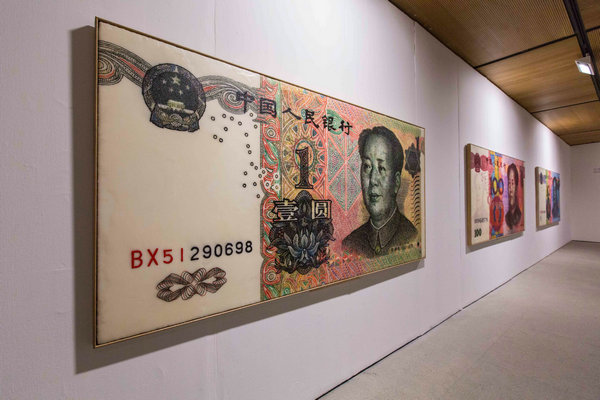
The RMB series offers Chinese audiences an unusual way to see "the beauty of the money itself", the artist says.(Photo provided to China Daily)
Spanish encaustic painter Jose-Maria Cano is displaying his works at an ongoing retrospective show in Beijing.
His paintings, made by mixing color with hot wax, exhibit the two main themes of his art-materialism and spiritualism.
Cano's show, Differences and Similarities Between Reality and Truth, which continues through March 23, displays 11 series of some 200 paintings he produced since 2003, including his well-known Wall Street 100, a collection of large-size images of public figures whose photos appeared in the Wall Street Journal. He started the series in 2004, long before a meltdown hit U.S. investment banks.
For his Beijing exhibition, Cano, 57, added two special sections. The RMB series presents massive Chinese currency notes in denominations of 1, 10 and 100. The Beijing series features one landscape painting of the present-day city and its landmark buildings, and another from 1930s China, based on the Tintin book The Blue Lotus to show the changes in cities here.
The paintings of bank notes offer audiences an unusual way to clearly see the details of money, something they pay little attention to daily. One needs to see "the beauty of the money itself", Cano says.
"The portrait of Mao Zedong on a 100 yuan note is beautiful. So is the color and the watermark," he says, adding that he makes money paintings just like he would paint colorful gardens.
Besides the yuan, Cano has also painted pounds, marks and euros. He says it's an ironic way to show beauty because rich people are considered "beautiful" and painters are "obliged to paint beauty".
Cano has visited Beijing a few times, and it is the first time that the Central Academy of Fine Arts, an art school that produces well-known artists, is hosting his works at its art museum.
During his first visit to the country in 2006, he went to Shanghai and saw how the economy was growing, he says.
On display are also many wax paintings inspired by newspapers' layouts.
It takes months to produce an encaustic painting, he says. He has dedicated more than a decade to the art form, and now has a distinctive style.
Wang Huangsheng, curator of the show and director of the CAFA's Art Museum, says it's difficult to make wax paintings, an art form that probably originated in Greece 2,000 years ago.
Some Chinese artists tried this kind of painting in the 1990s but eventually gave up.
"When he showed me his works at his London studio, I was attracted to them by the energy. I then decided to hold a show for him in China," Wang says.
Wang had also suggested that Cano's musical side be displayed at the show. But Cano, who was a full-time musician until he became a painter, said he would stick with paintings.
In the 1980s, the artist gained fame as a member of Spanish pop band Mecano. He also wrote songs for famous singers like Placido Domingo.
More than a decade ago, he stepped into the world of painting, which he says has much similarities with his past career. He draws on music for his expressionism, such as the bullfighters' series.
Manuel Valencia, Spain's ambassador in Beijing, says: "We often listened to his music. Painting is just another language for him to express himself. His art is as energetic as his music."
If you go
9:30 am-5:30 pm, through March 23. Art Museum of the Central Academy of Fine Arts, 8 Huajiadi South Street, Chaoyang district, Beijing. 010-6477-1575.


















































